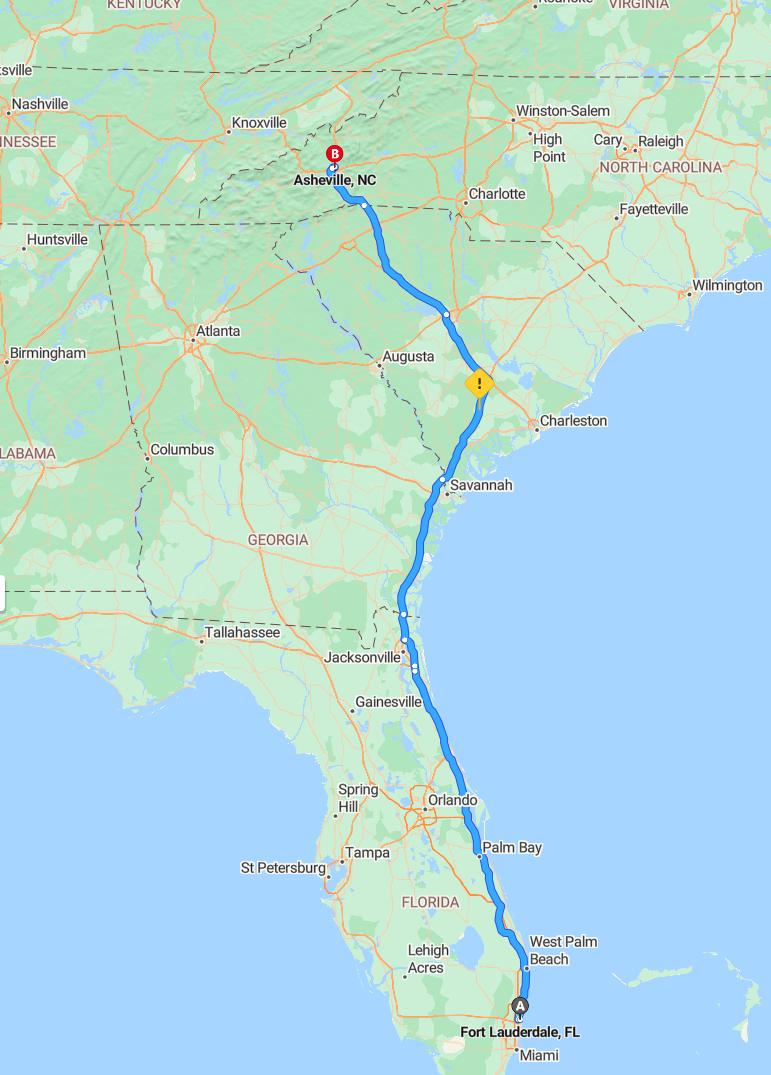Distance and estimated driving time
The journey from Fort Lauderdale to Asheville covers approximately 768 miles, primarily along I-95 N and I-26 W. Travel time is estimated to be around 10 hours and 30 minutes, depending on traffic conditions. This route offers a scenic transition from the coastal city to the mountainous landscape of Asheville. Planning ahead for rest stops and possible delays can ensure a smooth and enjoyable trip.
Driving route
Embarking on a journey from Fort Lauderdale to Asheville offers a diverse and scenic route through the southeastern United States. Starting in Fort Lauderdale, travelers will pass through vibrant cities like West Palm Beach, Palm Bay, and Orlando, each offering unique cultural and entertainment options. Continuing north, the route takes you through Gainesville, Jacksonville, and the historic charm of Savannah and Charleston, known for their rich history and southern hospitality. Finally, the trip culminates in the mountain town of Asheville, renowned for its vibrant arts scene, historic architecture, and breathtaking natural beauty. This drive provides an excellent opportunity to explore a variety of landscapes, historic sites, and cultural landmarks along the way.

Best time to depart
The best time to depart from Fort Lauderdale to Asheville is early in the morning, ideally around 6 or 7 AM, to avoid heavy traffic congestion in urban areas like West Palm Beach, Orlando, and Jacksonville. Leaving early also allows for a more relaxed drive, giving ample time to enjoy scenic stops along the route such as Savannah and Charleston. Traveling during weekdays, particularly Tuesday or Wednesday, can help avoid weekend travel delays when tourist spots and local travelers increase traffic volume. Additionally, considering seasonal weather patterns, it's advisable to depart in spring or fall to avoid summer storms or winter weather that could impact driving conditions.
Recommended rest stops and attractions
When driving from Fort Lauderdale to Asheville, it's essential to plan rest stops and explore attractions along the way to enhance your trip. In West Palm Beach, consider visiting the Norton Museum of Art or relaxing at nearby beaches, while in Orlando, a break at Lake Eola Park provides a scenic reprieve. Jacksonville offers excellent options such as the Jacksonville Zoo and Metropolitan Park for stretching your legs, and in Savannah, take time to stroll through historic districts or visit Forsyth Park. As you approach Asheville, explore nearby attractions like the Great Smoky Mountains or the Biltmore Estate to enrich your journey before arriving at your final destination.
Weather forecast along the route
Traveling from Fort Lauderdale to Asheville, travelers can expect a varied weather pattern along the route. In Florida, the climate is typically warm and humid, with occasional thunderstorms, especially near West Palm Beach and Orlando. As the journey moves northward, temperatures gradually cool, and travelers may encounter milder conditions with the possibility of rain in Jacksonville and Savannah. Upon reaching Charleston and Asheville, cooler temperatures and more stable weather are common, making for a comfortable drive through the scenic landscapes of the southeastern United States.
Road conditions and potential delays
The road from Fort Lauderdale to Asheville takes travelers through a variety of urban and rural areas, with typical highway conditions that are generally smooth and well-maintained. However, drivers should anticipate potential delays due to seasonal traffic, especially around major cities like Orlando and Jacksonville, as well as possible congestion near popular tourist destinations such as Savannah and Charleston. Weather conditions can also impact driving, particularly during hurricane season or heavy rain, which may slow traffic or cause temporary closures. It is advisable to check real-time traffic updates before and during the journey to ensure a smooth trip and avoid unexpected delays.
Fuel and food options
While driving from Fort Lauderdale to Asheville, travelers will find a variety of fuel stations and dining options along the route. Major cities such as West Palm Beach, Orlando, Jacksonville, and Charleston offer numerous gas stations, including well-known brands like Shell, BP, and GasBuddy, ensuring convenient refueling stops. These cities also feature diverse restaurants ranging from fast food chains to local eateries, providing opportunities to enjoy regional cuisines and quick bites. For travelers seeking a more relaxed experience, smaller towns like Gainesville, Savannah, and Palm Bay offer unique cafes and roadside diners, making it easy to rest, refuel both vehicle and body, and continue the journey comfortably.
Scenic viewpoints and photo spots
Embarking on a drive from Fort Lauderdale to Asheville offers numerous scenic viewpoints and photo opportunities along the way. In West Palm Beach and Palm Bay, travelers can enjoy waterfront views and vibrant cityscapes perfect for capturing sunset moments. Orlando's scenic parks and lakes provide lush backdrops, while Gainesville offers picturesque university campus scenes and surrounding nature. As you approach Asheville, the route NE Xplore viewpoints near Savannah and Charleston showcase historic architecture and coastal panoramas, culminating in the scenic mountain vistas of Asheville, ideal for memorable photographs.
Safety tips for long drive
Embarking on a long drive from Fort Lauderdale to Asheville requires careful preparation and attention to safety. It's important to take regular breaks every two hours to rest, stretch, and stay alert, reducing the risk of fatigue. Ensure your vehicle is in good condition by checking tire pressure, brakes, and fluid levels before departure. Additionally, stay vigilant by avoiding distractions, obeying traffic laws, and keeping your focus on the road to make your journey as safe and enjoyable as possible.
Alternative routes and travel tips
When driving from Fort Lauderdale to Asheville, consider alternative routes such as taking I-95 north to Savannah and then transitioning to I-26 west, which can sometimes offer smoother traffic flow. For a more scenic experience, detouring through smaller coastal towns along US-1 or exploring the US-301 corridor may enrich your trip. To enhance your journey, plan for fuel and rest stops at notable cities like Jacksonville and Charleston, and stay updated on real-time traffic conditions via navigation apps. Additionally, traveling during off-peak hours can help avoid congestion, ensuring a more comfortable and efficient drive to your final destination.
